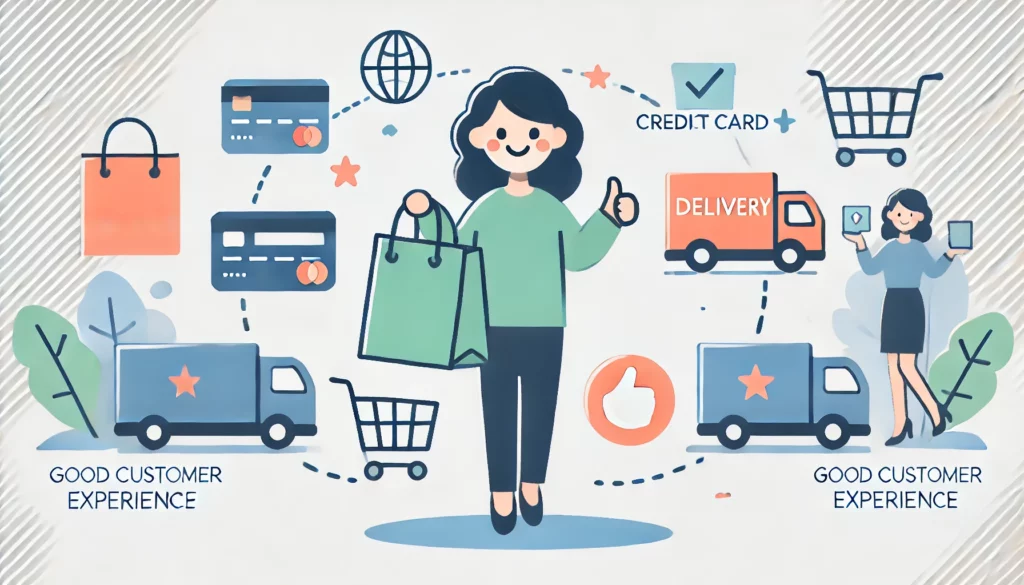So, you want to start an e-commerce business in 2024? You’ve picked an exciting time to dive in! The digital marketplace is buzzing with innovation and new opportunities. From hyper-personalized shopping experiences and voice commerce to mobile-first designs and the booming world of social commerce, staying on top of these trends is crucial. Let’s explore the key e-commerce trends that will shape your business success in 2024 and beyond.
1. Personalized Customer Experiences
In 2024, personalization it’s a necessity. Customers expect tailored experiences at every touchpoint, from personalized recommendations to bespoke customer service. This means leveraging data analytics and AI to understand customer behavior and preferences. Retailers are increasingly using AI to offer hyper-personalized experiences, ensuring that each interaction feels unique and relevant to the customer.
Benefits of Personalization in E-Commerce
- Increased Customer Loyalty: Personalized experiences make customers feel valued, which can lead to increased loyalty. Customers are more likely to return to a retailer that remembers their preferences and offers relevant recommendations.
- Higher Conversion Rates: When customers see products that match their tastes and needs, they are more likely to make a purchase. Personalization can significantly boost conversion rates by presenting the right products at the right time.
- Improved Customer Satisfaction: Tailored interactions enhance the overall customer experience. When customers feel understood and appreciated, their satisfaction levels rise, leading to positive reviews and referrals.
Implementing Personalization Strategies
To successfully implement personalization, businesses need to focus on collecting and analyzing data effectively. Here are some strategies:
- Utilize Advanced Analytics Tools: Invest in tools that can track and analyze customer behavior across multiple channels. This data is crucial for understanding customer preferences and predicting future actions.
- Leverage Machine Learning: Machine learning algorithms can identify patterns and trends in customer data, enabling businesses to make more informed decisions about product recommendations and marketing strategies.
- Integrate Customer Feedback: Regularly gather and analyze customer feedback to refine personalization strategies. Understanding customer opinions and experiences can help businesses tailor their offerings more accurately.
- Implement Dynamic Content: Use dynamic content on websites and emails that changes based on the customer’s previous interactions and preferences. This approach ensures that each customer sees the most relevant information and offers.
Challenges and Considerations
While personalization offers many benefits, it also comes with challenges. One of the main concerns is data privacy. Customers are becoming increasingly aware of how their data is being used and expect businesses to handle it responsibly. Transparency about data usage and robust security measures are essential to maintaining customer trust.

2. The Rise of Voice Assistants
With the rise of smart speakers and voice assistants, voice commerce is becoming a significant trend. In the U.S., about 40% of internet users engage with voice assistants monthly. Optimizing your e-commerce site for voice search involves understanding natural language patterns and ensuring your content is concise and clear. Major retailers are already enabling voice-based orders, making it essential for businesses to adapt.
Optimizing for Voice Search
To capitalize on the voice commerce trend, businesses must understand how voice search differs from traditional text search. Voice queries are typically longer and more conversational. For example, instead of typing “best coffee maker,” a user might ask, “What is the best coffee maker for a small kitchen?” This natural language pattern requires a different approach to SEO.
Key Strategies for Voice Search Optimization:
- Focus on Long-Tail Keywords: Since voice searches are more conversational, targeting long-tail keywords that mimic natural speech patterns is essential.
- Answer Questions Directly: Structure your content to answer common questions related to your products. Use headings that reflect these questions and provide concise, clear answers.
- Enhance Local SEO: Many voice searches are local, such as “Where can I find a bakery near me?” Optimizing your site for local search terms and ensuring your business information is up-to-date can help capture this traffic.
- Use Schema Markup: Implementing schema markup can help search engines understand the context of your content, improving the chances of your site being featured in voice search results.
Challenges and Considerations
While voice commerce presents numerous opportunities, it also comes with challenges:
- Privacy Concerns: As with any technology that collects data, voice assistants raise privacy issues. Businesses must ensure that customer data is handled securely and transparently.
- Accuracy of Voice Recognition: Ensuring that voice assistants accurately understand and process commands is critical. Misinterpretations can lead to customer frustration and lost sales.
- Brand Visibility: In a voice-first world, securing the top spot in search results becomes even more crucial, as voice assistants typically provide a single answer to queries.

3. Mobile-First Design
The dominance of mobile commerce continues to grow. In 2024, mobile shopping is expected to account for 60% of all e-commerce sales. This shift means that businesses must prioritize mobile-first design, ensuring seamless user experiences on smartphones. Features like fingerprint and facial recognition for authentication, dedicated mobile apps, and mobile-friendly payment options are now critical for engaging mobile shoppers.
Key Elements of Mobile-First Design
To succeed in a mobile-dominated market, e-commerce businesses need to focus on several critical elements of mobile-first design:
- Responsive Design: A responsive website automatically adjusts to fit the screen size of any device, providing a consistent and user-friendly experience whether accessed from a smartphone, tablet, or desktop.
- Fast Loading Times: Mobile users expect fast and efficient browsing. Optimizing images, leveraging content delivery networks (CDNs), and minimizing code can help ensure that pages load quickly.
- User-Friendly Navigation: Simplified menus, intuitive touch controls, and easy-to-find search functions enhance the mobile shopping experience.
- Mobile-Friendly Payment Options: Offering payment methods like Apple Pay, Google Pay, and other mobile wallets can streamline the checkout process, reducing cart abandonment rates.
Best Practices for Mobile Optimization
To ensure a smooth and engaging mobile experience, e-commerce businesses should follow these best practices:
- Simplify the User Interface (UI): Keep the design clean and uncluttered. Prioritize essential information and features, and use ample white space to avoid overwhelming the user.
- Optimize for Touch: Ensure that buttons and links are large enough to be easily tapped with a finger. Avoid using hover effects that are not supported on touchscreens.
- Streamline the Checkout Process: Reduce the number of steps required to complete a purchase. Autofill forms, guest checkout options, and stored payment information can help speed up the process.
- Leverage Analytics: Use mobile-specific analytics to track user behavior and identify areas for improvement. Understanding how customers interact with your mobile site can help you make data-driven decisions.

4. The Rise of Social Commerce
Social media platforms are transforming into powerful sales channels. With features like shoppable posts and in-app purchasing, platforms like Instagram, Facebook, and TikTok are becoming integral to e-commerce strategies. Social commerce allows brands to reach consumers where they spend most of their time, creating seamless shopping experiences directly within social media apps.
One of the most impactful developments in social commerce is the advent of shoppable posts. These allow users to view product details and make purchases without leaving the social media app. Instagram, for example, offers Instagram Shopping, where businesses can create a digital storefront to showcase their products directly on their profile. Users can click on tagged products in posts, stories, and even live videos to view product details and make purchases.
Similarly, Facebook Shops enable businesses to set up customizable online stores accessible from both Facebook and Instagram. These shops provide a cohesive shopping experience across the platforms, making it easy for customers to browse and buy products. TikTok has also entered the fray with TikTok Shopping, which integrates with major e-commerce platforms to allow in-app purchasing. This feature leverages the platform’s viral nature, enabling users to discover products through engaging content.
Benefits of Social Commerce
- Increased Reach and Visibility: Social media platforms have vast user bases, providing businesses with the opportunity to reach a global audience. By leveraging shoppable posts and in-app purchasing, brands can enhance their visibility and attract potential customers who are already engaged with the platform.
- Enhanced Engagement: Social commerce facilitates more interactive and engaging shopping experiences. Users can comment on products, share their favorite items, and interact with brands in real-time, fostering a sense of community and loyalty.
- Seamless Shopping Experience: The integration of shopping features within social media apps streamlines the purchasing process. Customers can move from discovery to purchase without navigating away from the platform, reducing friction and increasing conversion rates.
Strategies for Leveraging Social Commerce
To effectively harness the power of social commerce, businesses should consider the following strategies:
- Create Compelling Visual Content: High-quality images and videos are crucial for capturing attention on social media. Invest in professional photography and engaging video content that showcases your products in the best light.
- Utilize Influencer Partnerships: Collaborating with influencers can amplify your reach and credibility. Influencers can create authentic content featuring your products, driving their followers to explore and purchase.
- Engage with Your Audience: Active engagement with followers through comments, direct messages, and live sessions can build a loyal customer base. Responding to inquiries and feedback promptly demonstrates excellent customer service and fosters trust.

5. Sustainability and Ethical Shopping
Consumers are increasingly mindful of their environmental impact, and this trend is influencing e-commerce. Brands that adopt sustainable practices—such as eco-friendly packaging, carbon-neutral shipping, and ethical sourcing—are resonating more with consumers. This shift towards green consumerism not only attracts environmentally conscious customers but also helps businesses differentiate themselves in a crowded market.
Why Sustainability Matters
The growing concern over climate change and environmental degradation has led consumers to become more selective about the brands they support. Today’s shoppers are looking for companies that not only provide high-quality products but also demonstrate a commitment to sustainability and ethical practices. This shift is driven by a combination of factors, including increased awareness of environmental issues, greater access to information, and a desire to contribute to positive change through purchasing decisions.
Key Sustainable Practices in E-Commerce
- Eco-Friendly Packaging: Reducing packaging waste is a critical component of sustainable e-commerce. Brands are increasingly using recyclable, biodegradable, or compostable materials to minimize their environmental footprint. Companies like Patagonia and Lush have set benchmarks by using minimal and sustainable packaging for their products.
- Carbon-Neutral Shipping: To offset the carbon emissions generated by shipping, many businesses are adopting carbon-neutral practices. This involves calculating the carbon footprint of deliveries and investing in environmental projects that reduce carbon emissions, such as reforestation or renewable energy initiatives. Companies like Shopify and Allbirds are leading the way by offering carbon-neutral shipping options.
- Ethical Sourcing: Ensuring that products are sourced ethically is another vital aspect of sustainable e-commerce. This means choosing suppliers who adhere to fair labor practices, pay fair wages, and do not engage in exploitative labor practices. Ethical sourcing also involves considering the environmental impact of raw materials and opting for sustainable alternatives when possible. Brands like Everlane and The Body Shop emphasize transparency and ethical sourcing in their business models.
Benefits of Sustainable and Ethical Practices
- Attracting Conscious Consumers: By adopting sustainable practices, businesses can attract environmentally conscious consumers who prioritize sustainability in their purchasing decisions. This growing segment of the market is willing to pay a premium for products that align with their values.
- Brand Differentiation: In a crowded market, sustainability can be a key differentiator. Brands that demonstrate a commitment to ethical and eco-friendly practices can stand out from competitors and build a loyal customer base.
- Regulatory Compliance and Risk Mitigation: As governments around the world implement stricter environmental regulations, adopting sustainable practices can help businesses stay compliant and avoid potential fines. Additionally, it mitigates risks associated with supply chain disruptions due to environmental factors.
- Positive Brand Image and Reputation: Companies that prioritize sustainability and ethical practices often enjoy a positive brand image and reputation. This can lead to increased customer loyalty, positive word-of-mouth, and greater overall brand value.
Implementing Sustainability in E-Commerce
To effectively implement sustainability in e-commerce, businesses can take several actionable steps:
- Conduct a Sustainability Audit: Assess current practices and identify areas for improvement. This can include evaluating packaging materials, supply chain processes, and energy usage.
- Set Clear Sustainability Goals: Establish measurable goals for reducing environmental impact. This could involve setting targets for reducing carbon emissions, increasing the use of recyclable materials, or sourcing a higher percentage of products from ethical suppliers.
- Engage with Stakeholders: Collaborate with suppliers, employees, and customers to promote sustainability. Transparency and communication are key to building trust and ensuring that all stakeholders are aligned with sustainability objectives.

6. Enhancing Customer Support
Quality customer support remains a cornerstone of successful e-commerce businesses. Live chat and AI-driven chatbots are becoming essential tools for providing instant assistance and improving customer satisfaction. Companies that invest in responsive, 24/7 support options are likely to see higher customer retention and loyalty.
Live Chat: Real-Time Assistance
Live chat is a powerful tool that allows customers to get immediate help without leaving the website. It is especially effective for addressing simple queries, guiding users through the purchasing process, and resolving minor issues quickly. Live chat provides several benefits:
- Instant Response: Customers receive real-time responses, reducing wait times and enhancing satisfaction.
- Multitasking Capability: Support agents can handle multiple chats simultaneously, increasing efficiency.
- Personalized Interaction: Live chat enables personalized communication, making customers feel heard and valued.
Many businesses integrate live chat with their CRM systems to ensure that support agents have access to customer history and preferences, allowing for more personalized and effective assistance.
AI-Driven Chatbots: Efficiency and Scalability
AI-driven chatbots are transforming customer support by providing round-the-clock assistance. These chatbots can handle a wide range of tasks, from answering frequently asked questions to processing orders and tracking shipments. The benefits of using AI-driven chatbots include:
- 24/7 Availability: Chatbots can provide support at any time, ensuring that customers receive help whenever they need it.
- Consistency: Chatbots deliver consistent responses, ensuring that customers receive accurate information every time.
- Cost-Effective: Implementing chatbots can reduce the need for a large support team, lowering operational costs.
Advanced chatbots use natural language processing (NLP) to understand and respond to customer queries in a human-like manner. They can also learn from interactions, improving their responses over time.
Combining Human and AI Support
While AI-driven chatbots are highly effective, there are instances where human intervention is necessary. Complex queries, sensitive issues, and customers who prefer human interaction should be directed to live agents. A hybrid approach that combines the efficiency of AI with the empathy of human agents ensures that all customer needs are met effectively.

7. Prioritizing Cybersecurity
With the increasing number of online transactions, cybersecurity has become a critical concern for e-commerce businesses. Implementing robust security measures such as multi-factor authentication, secure payment gateways, and end-to-end encryption is essential to protect customer data. Leveraging AI and machine learning for fraud detection and prevention can further enhance security and build customer trust.
Key Cybersecurity Measures for E-Commerce
- Multi-Factor Authentication (MFA): MFA adds an extra layer of security by requiring users to provide two or more verification factors to gain access to their accounts. This can include something the user knows (password), something the user has (smartphone or token), and something the user is (fingerprint or facial recognition).
- Secure Payment Gateways: Secure payment gateways ensure that sensitive payment information is transmitted safely. These gateways use encryption to protect data during transmission and comply with standards like PCI DSS (Payment Card Industry Data Security Standard) to ensure secure handling of cardholder information.
- End-to-End Encryption: Encryption protects data by converting it into a code that can only be deciphered by authorized parties. End-to-end encryption ensures that data is encrypted throughout its entire journey, from the user’s device to the e-commerce platform’s servers.
- AI and Machine Learning for Fraud Detection: AI and machine learning algorithms can analyze vast amounts of data to identify patterns and anomalies that may indicate fraudulent activity. These technologies can provide real-time detection and prevention, reducing the risk of fraud and enhancing overall security.
Advanced Cybersecurity Solutions
To further bolster security, e-commerce businesses can leverage advanced solutions like Rhyno GUARD MDR and Bwired IT Services.
Rhyno GUARD MDR
Rhyno GUARD Managed Detection and Response (MDR) is a comprehensive cybersecurity solution designed to provide 24/7 monitoring, detection, and response to cyber threats. It combines advanced technology with human expertise to deliver proactive threat hunting, continuous monitoring, and rapid incident response. Key features include:
- Threat Intelligence: Utilizes global threat intelligence to stay ahead of emerging threats.
- Behavioral Analysis: Monitors user and system behavior to detect anomalies.
- Rapid Response: Provides immediate incident response to contain and mitigate threats.
- Continuous Monitoring: Offers round-the-clock surveillance to detect and respond to threats in real-time.
By integrating Rhyno GUARD MDR, e-commerce businesses can ensure robust protection against cyber threats and enhance their overall security posture.

Bwired IT Services
Bwired IT Services offers a range of cybersecurity solutions tailored to the needs of e-commerce businesses. Their services include:
- Cybersecurity Assessments: Comprehensive evaluations of the current security landscape to identify vulnerabilities and recommend improvements.
- Network Security: Implementation of firewalls, intrusion detection systems, and secure network architectures to protect against cyber attacks.
- Data Protection: Solutions for data encryption, secure backup, and disaster recovery to safeguard critical information.
- Compliance Management: Assistance with regulatory compliance, ensuring that businesses meet industry standards and legal requirements.
Bwired IT Services provides a holistic approach to cybersecurity, combining technical expertise with strategic insights to help businesses protect their assets and maintain customer trust.
Conclusion
Prioritizing cybersecurity is essential for the success and integrity of e-commerce businesses. By implementing robust security measures, leveraging advanced solutions like Rhyno GUARD MDR and Bwired IT Services, and adopting a proactive approach to threat detection and response, businesses can protect their customers and their reputation. As the digital landscape continues to evolve, staying ahead of cyber threats will be crucial for maintaining trust and ensuring long-term success.
At Bwired IT Services, we can develop your e-commerce site and implement cybersecurity measures to keep your investment safe. Ready to enhance your e-commerce security? Reach out for more insights and practical tips on implementing advanced cybersecurity solutions.
